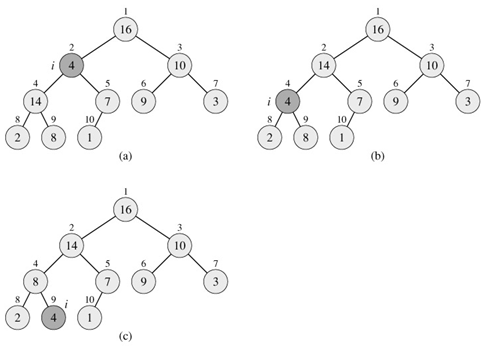Maintaining The Heap Property
Maintaining the heap property
MAX-HEAPIFY is an important subroutine for manipulating max-heaps. Its inputs are an array A and an index i into the array. When MAX-HEAPIFY is called, it is assumed that the binary trees rooted at LEFT(i) and RIGHT(i) are max-heaps, but that A[i] may be smaller than its children, thus violating the max-heap property. The function of MAX-HEAPIFY is to let the value at A[i] "float down" in the max-heap so that the subtree rooted at index i becomes a max-heap.
MAX-HEAPIFY(A, i)
1 l ← LEFT(i)
2 r ← RIGHT(i)
3 if l ≤ heap-size[A] and A[l] > A[i]
4 then largest ← l
5 else largest ← i
6 if r ≤ heap-size[A] and A[r] > A[largest]
7 then largest ← r
8 if largest ≠ i
9 then exchange A[i] ↔ A[largest]
10 MAX-HEAPIFY(A, largest)
Figure 6.2illustrates the action of MAX-HEAPIFY. At each step, the largest of the elements A[i], A[LEFT(i)], and A[RIGHT(i)] is determined, and its index is stored in largest. If A[i] is largest, then the subtree rooted at node i is a max-heap and the procedure terminates. Otherwise, one of the two children has the largest element, and A[i] is swapped with A[largest], which causes node i and its children to satisfy the max-heap property. The node indexed by largest, however, now has the original value A[i], and thus the subtree rooted at largest may violate the max-heap property. Consequently, MAX-HEAPIFY must be called recursively on that subtree.

Figure 6.2: The action of MAX-HEAPIFY(A, 2), where heap-size[A] = 10. (a) The initial configuration, with A[2] at node i = 2 violating the max-heap property since it is not larger than both children. The max-heap property is restored for node 2 in (b) by exchanging A[2] with A[4], which destroys the max-heap property for node 4. The recursive call MAX-HEAPIFY (A, 4) now has i = 4. After swapping A[4] with A[9], as shown in (c), node 4 is fixed up, and the recursive call MAX-HEAPIFY(A, 9) yields no further change to the data structure.
The running time of MAX-HEAPIFY on a subtree of size n rooted at given node i is the Θ(1) time to fix up the relationships among the elements A[i], A[LEFT(i)], and A[RIGHT(i)], plus the time to run MAX-HEAPIFY on a subtree rooted at one of the children of node i. The children's subtrees each have size at most 2n/3-the worst case occurs when the last row of the tree is exactly half full-and the running time of MAX-HEAPIFY can therefore be described by the recurrence
T(n) ≤ T(2n/3) Θ(1).
The solution to this recurrence, by case 2 of the master theorem (Theorem 4.1), is T (n) = O(lg n). Alternatively, we can characterize the running time of MAX-HEAPIFY on a node of height h as O(h).